Analyzing Socioeconomic Groups and Health Promotion Approaches
VerifiedAdded on 2023/01/18
|9
|3054
|27
Essay
AI Summary
This essay critically examines the avoidable differences in health and well-being experienced by different socioeconomic groups, highlighting disparities in income, education, and access to healthcare. It discusses how lower socioeconomic groups face higher rates of physical and mental health problems, limited access to medical care, and adverse living conditions, while higher-income groups may encounter health risks related to lifestyle choices. The essay further explores various approaches in health and public health that can work towards reducing inequalities, such as building hospitals in underserved areas, providing affordable interventions, promoting equal employment opportunities, and educating individuals about chronic diseases and healthy lifestyles. It emphasizes the importance of healthcare professionals treating all individuals equally and adopting a Health in All Policies approach to embed action on health inequalities across various sectors, aiming to improve the health and well-being outcomes for all socioeconomic groups. Desklib provides a platform for students to access this essay and other study resources.
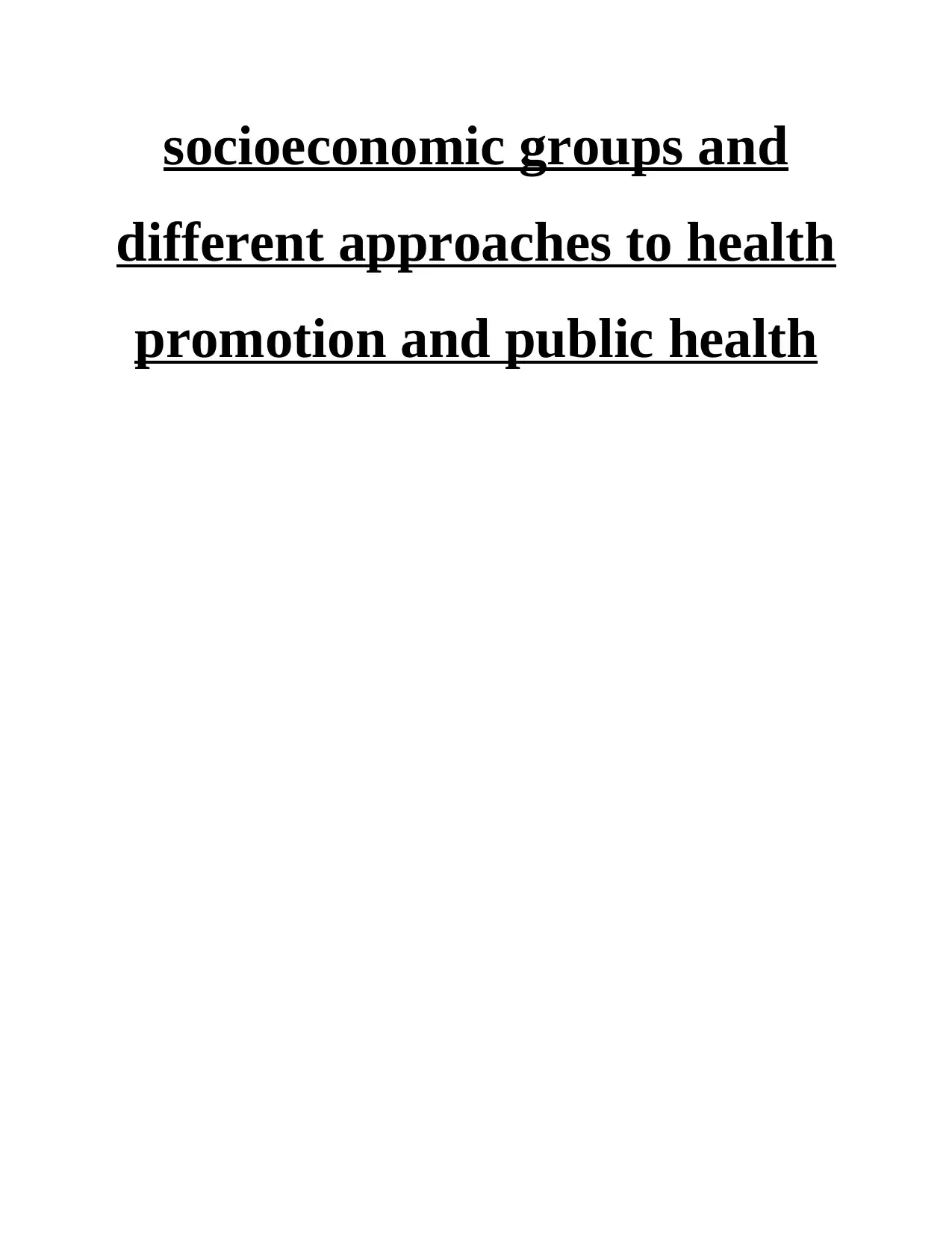
socioeconomic groups and
different approaches to health
promotion and public health
different approaches to health
promotion and public health
Paraphrase This Document
Need a fresh take? Get an instant paraphrase of this document with our AI Paraphraser
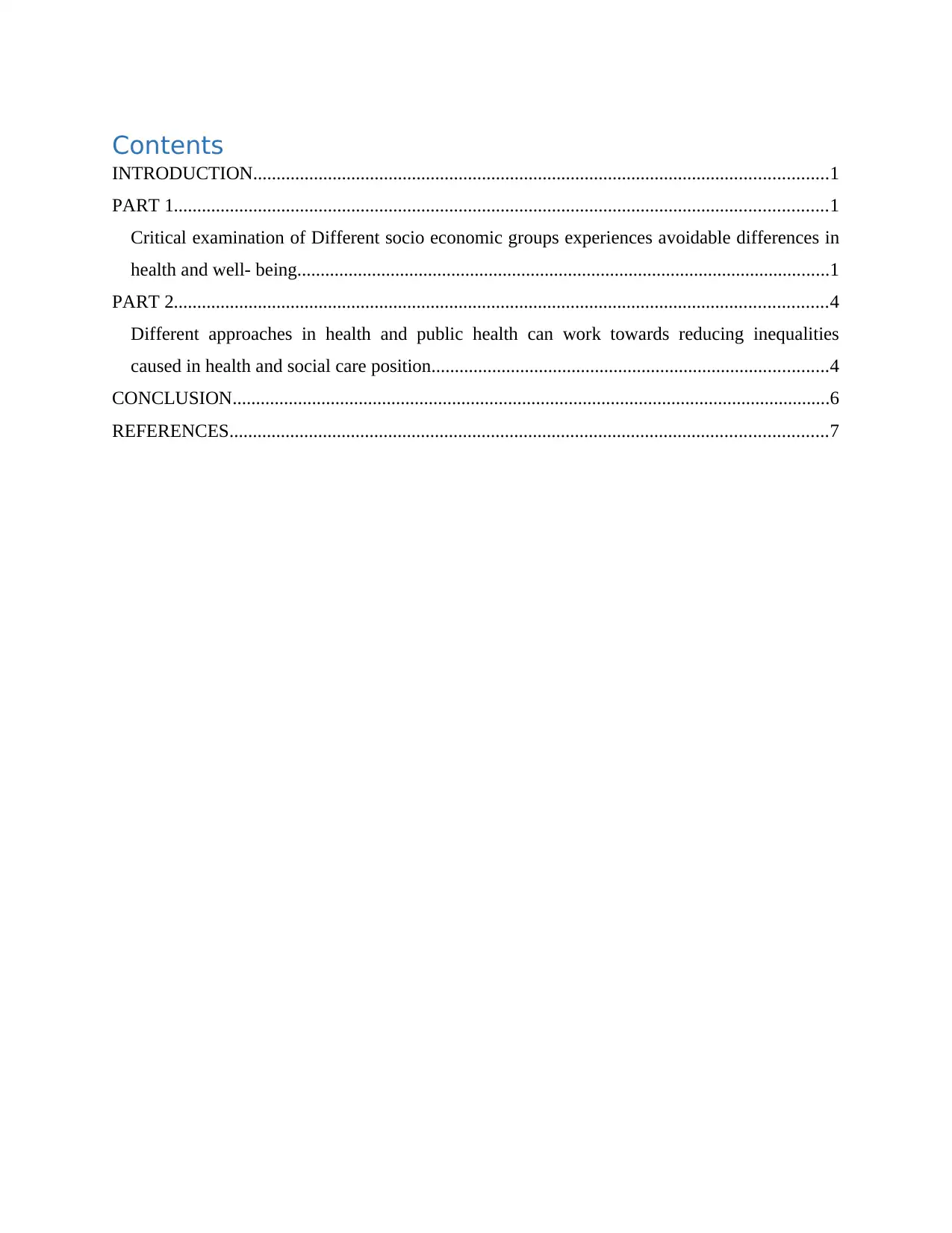
Contents
INTRODUCTION...........................................................................................................................1
PART 1............................................................................................................................................1
Critical examination of Different socio economic groups experiences avoidable differences in
health and well- being..................................................................................................................1
PART 2............................................................................................................................................4
Different approaches in health and public health can work towards reducing inequalities
caused in health and social care position.....................................................................................4
CONCLUSION................................................................................................................................6
REFERENCES................................................................................................................................7
INTRODUCTION...........................................................................................................................1
PART 1............................................................................................................................................1
Critical examination of Different socio economic groups experiences avoidable differences in
health and well- being..................................................................................................................1
PART 2............................................................................................................................................4
Different approaches in health and public health can work towards reducing inequalities
caused in health and social care position.....................................................................................4
CONCLUSION................................................................................................................................6
REFERENCES................................................................................................................................7
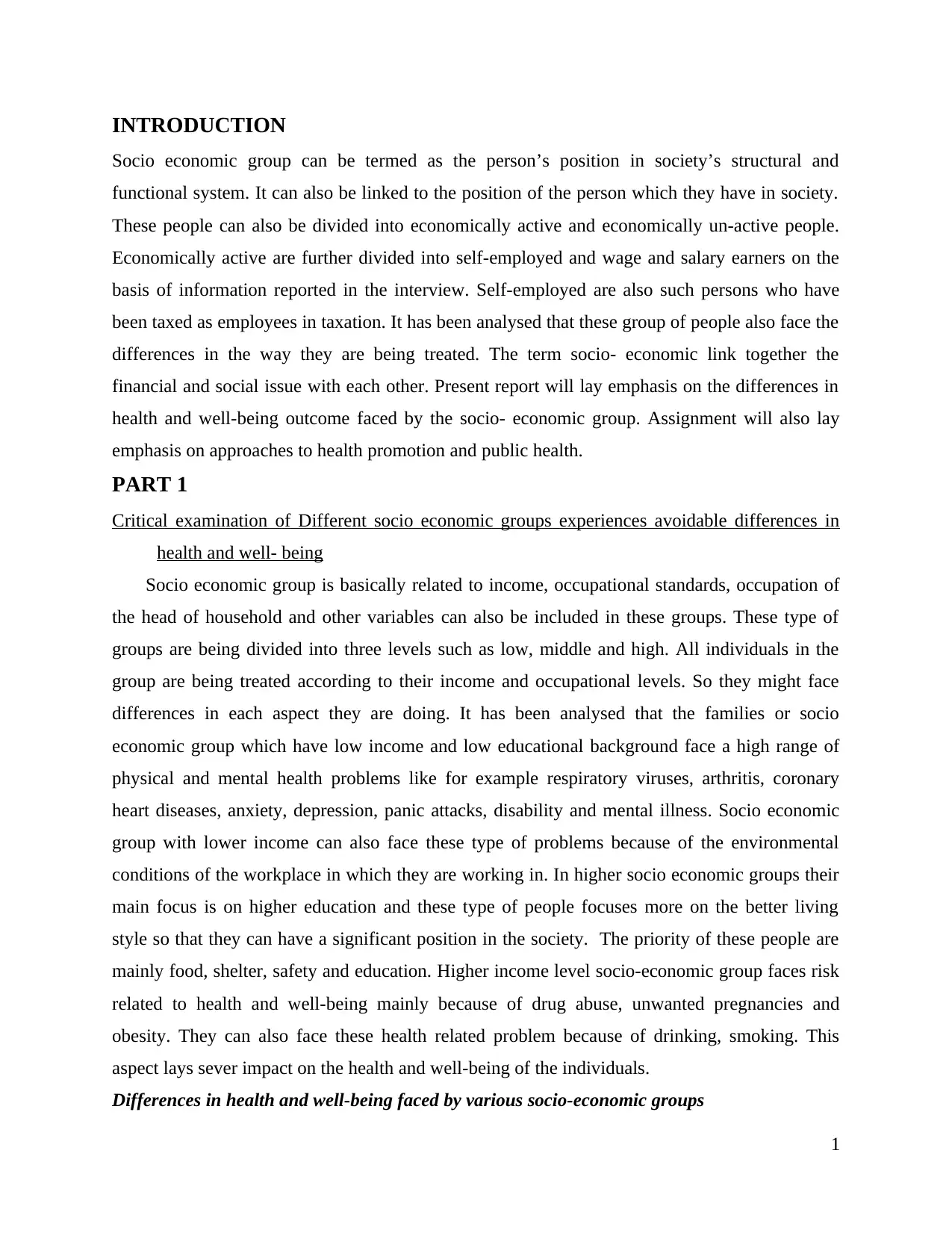
INTRODUCTION
Socio economic group can be termed as the person’s position in society’s structural and
functional system. It can also be linked to the position of the person which they have in society.
These people can also be divided into economically active and economically un-active people.
Economically active are further divided into self-employed and wage and salary earners on the
basis of information reported in the interview. Self-employed are also such persons who have
been taxed as employees in taxation. It has been analysed that these group of people also face the
differences in the way they are being treated. The term socio- economic link together the
financial and social issue with each other. Present report will lay emphasis on the differences in
health and well-being outcome faced by the socio- economic group. Assignment will also lay
emphasis on approaches to health promotion and public health.
PART 1
Critical examination of Different socio economic groups experiences avoidable differences in
health and well- being
Socio economic group is basically related to income, occupational standards, occupation of
the head of household and other variables can also be included in these groups. These type of
groups are being divided into three levels such as low, middle and high. All individuals in the
group are being treated according to their income and occupational levels. So they might face
differences in each aspect they are doing. It has been analysed that the families or socio
economic group which have low income and low educational background face a high range of
physical and mental health problems like for example respiratory viruses, arthritis, coronary
heart diseases, anxiety, depression, panic attacks, disability and mental illness. Socio economic
group with lower income can also face these type of problems because of the environmental
conditions of the workplace in which they are working in. In higher socio economic groups their
main focus is on higher education and these type of people focuses more on the better living
style so that they can have a significant position in the society. The priority of these people are
mainly food, shelter, safety and education. Higher income level socio-economic group faces risk
related to health and well-being mainly because of drug abuse, unwanted pregnancies and
obesity. They can also face these health related problem because of drinking, smoking. This
aspect lays sever impact on the health and well-being of the individuals.
Differences in health and well-being faced by various socio-economic groups
1
Socio economic group can be termed as the person’s position in society’s structural and
functional system. It can also be linked to the position of the person which they have in society.
These people can also be divided into economically active and economically un-active people.
Economically active are further divided into self-employed and wage and salary earners on the
basis of information reported in the interview. Self-employed are also such persons who have
been taxed as employees in taxation. It has been analysed that these group of people also face the
differences in the way they are being treated. The term socio- economic link together the
financial and social issue with each other. Present report will lay emphasis on the differences in
health and well-being outcome faced by the socio- economic group. Assignment will also lay
emphasis on approaches to health promotion and public health.
PART 1
Critical examination of Different socio economic groups experiences avoidable differences in
health and well- being
Socio economic group is basically related to income, occupational standards, occupation of
the head of household and other variables can also be included in these groups. These type of
groups are being divided into three levels such as low, middle and high. All individuals in the
group are being treated according to their income and occupational levels. So they might face
differences in each aspect they are doing. It has been analysed that the families or socio
economic group which have low income and low educational background face a high range of
physical and mental health problems like for example respiratory viruses, arthritis, coronary
heart diseases, anxiety, depression, panic attacks, disability and mental illness. Socio economic
group with lower income can also face these type of problems because of the environmental
conditions of the workplace in which they are working in. In higher socio economic groups their
main focus is on higher education and these type of people focuses more on the better living
style so that they can have a significant position in the society. The priority of these people are
mainly food, shelter, safety and education. Higher income level socio-economic group faces risk
related to health and well-being mainly because of drug abuse, unwanted pregnancies and
obesity. They can also face these health related problem because of drinking, smoking. This
aspect lays sever impact on the health and well-being of the individuals.
Differences in health and well-being faced by various socio-economic groups
1
⊘ This is a preview!⊘
Do you want full access?
Subscribe today to unlock all pages.

Trusted by 1+ million students worldwide

Socio-economic disparities are highly linked to the wide range of health related problems like
low birthweight, diseases related to heart, hypertension, arthritis, diabetes and cancer. It has been
analysed that the socio economic groups which have low level of income faces greater barrier in
accessing medical care. It has been interpreted that these type of individuals have less access to
health insurance, receive new drugs and technology and also they do not have access primary
and speciality care. These individuals are more at risk to heart disease, stroke, cancer and
diabetes. As it has been analysed that the socio economic group with higher income resides in
the area which has better living conditions, good food available to them, clean air and better
surroundings which makes their health and wellbeing condition better. It has been analysed in a
recent survey that the men and women who are living under-privileged and decline area in
England and have low source of income and belongs to lower socio economic group have
wellbeing scores of 48.6 for men and 47.3 for women, in comparison with 51.5 for men and 50.0
for women who are living in developed and urban area in England. The wellbeing scores are also
being measured by the body mass index and physical activity. This is being used to define the
overweight and the obesity. The men and women with lower income have the lowest wellbeing
score related to obesity. It has been 49.5 for men and 48.3 for women. This is because of these
individuals have no knowledge poor education related to the consumption proper diet. It has also
been analysed that the half of the children who are living in lower areas are suffering from
cavities and have more adverse health conditions. As they have no knowledge and also the
income related so that they can have access to better health service. For this government need to
take action so that individual this disparity can be reduced and the health outcome of them can be
better. The lower income group has the more risk for chronic conditions such as heart disease,
obesity has been analysed highest among the lower income groups. The older adults who have
less education and low income have the highest mortality rate and disability. (Kawachi,
Subramanian and Almeida-Filho, 2012). The people with disability are more vulnerable to these
diseases and can also face worsening conditions. So actions need to be taken on this. It has also
been analysed that disparities are also been find in children because of the lack of awareness and
consciousness. So they are more prone to diseases and poor health outcomes. It has been
analysed by the researchers that the low income people do not have the access to best hospitals,
they even do not have enough money to afford the best medical treatment, so their health
conditions are being going down and becoming adverse. High health care costs can throw
2
low birthweight, diseases related to heart, hypertension, arthritis, diabetes and cancer. It has been
analysed that the socio economic groups which have low level of income faces greater barrier in
accessing medical care. It has been interpreted that these type of individuals have less access to
health insurance, receive new drugs and technology and also they do not have access primary
and speciality care. These individuals are more at risk to heart disease, stroke, cancer and
diabetes. As it has been analysed that the socio economic group with higher income resides in
the area which has better living conditions, good food available to them, clean air and better
surroundings which makes their health and wellbeing condition better. It has been analysed in a
recent survey that the men and women who are living under-privileged and decline area in
England and have low source of income and belongs to lower socio economic group have
wellbeing scores of 48.6 for men and 47.3 for women, in comparison with 51.5 for men and 50.0
for women who are living in developed and urban area in England. The wellbeing scores are also
being measured by the body mass index and physical activity. This is being used to define the
overweight and the obesity. The men and women with lower income have the lowest wellbeing
score related to obesity. It has been 49.5 for men and 48.3 for women. This is because of these
individuals have no knowledge poor education related to the consumption proper diet. It has also
been analysed that the half of the children who are living in lower areas are suffering from
cavities and have more adverse health conditions. As they have no knowledge and also the
income related so that they can have access to better health service. For this government need to
take action so that individual this disparity can be reduced and the health outcome of them can be
better. The lower income group has the more risk for chronic conditions such as heart disease,
obesity has been analysed highest among the lower income groups. The older adults who have
less education and low income have the highest mortality rate and disability. (Kawachi,
Subramanian and Almeida-Filho, 2012). The people with disability are more vulnerable to these
diseases and can also face worsening conditions. So actions need to be taken on this. It has also
been analysed that disparities are also been find in children because of the lack of awareness and
consciousness. So they are more prone to diseases and poor health outcomes. It has been
analysed by the researchers that the low income people do not have the access to best hospitals,
they even do not have enough money to afford the best medical treatment, so their health
conditions are being going down and becoming adverse. High health care costs can throw
2
Paraphrase This Document
Need a fresh take? Get an instant paraphrase of this document with our AI Paraphraser
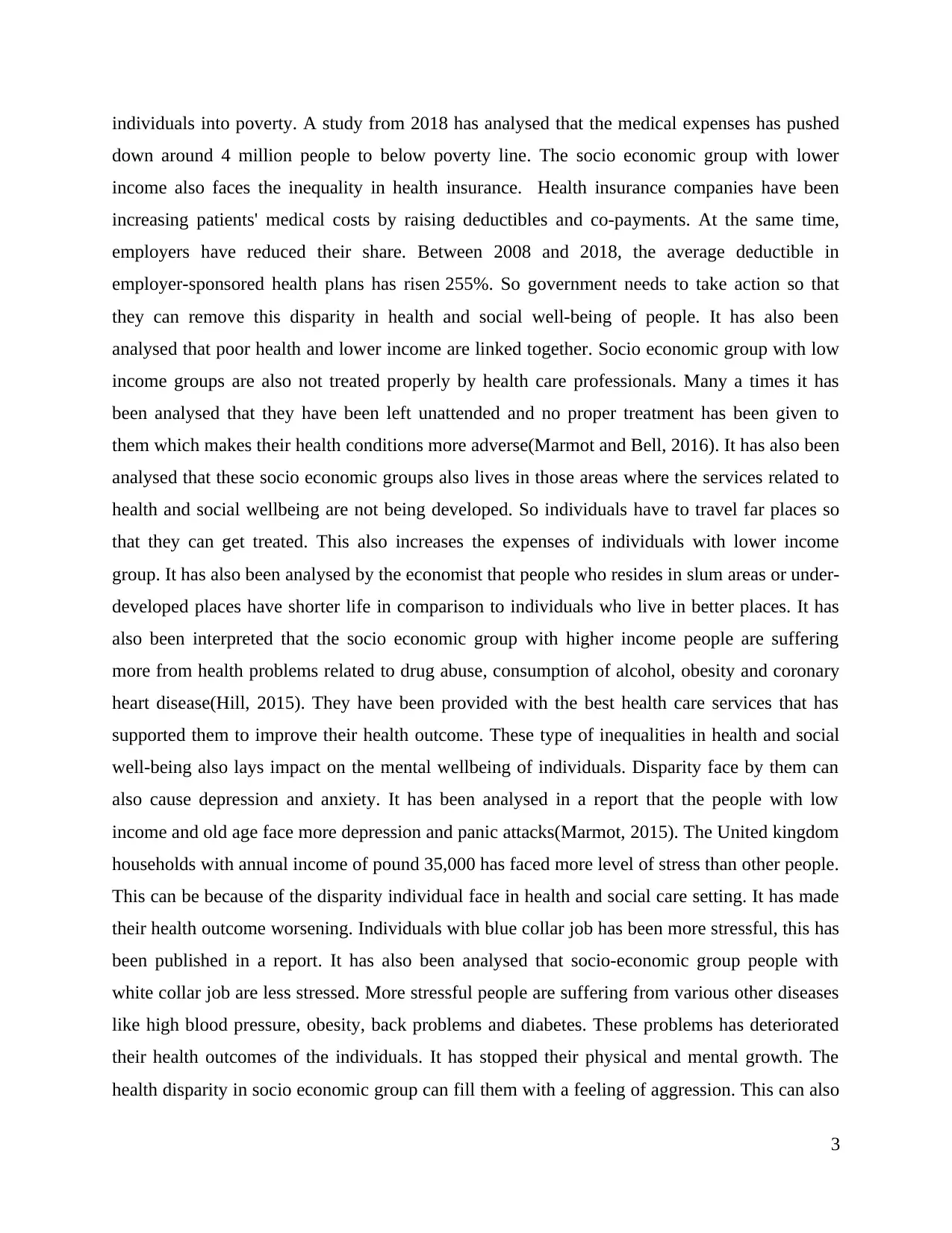
individuals into poverty. A study from 2018 has analysed that the medical expenses has pushed
down around 4 million people to below poverty line. The socio economic group with lower
income also faces the inequality in health insurance. Health insurance companies have been
increasing patients' medical costs by raising deductibles and co-payments. At the same time,
employers have reduced their share. Between 2008 and 2018, the average deductible in
employer-sponsored health plans has risen 255%. So government needs to take action so that
they can remove this disparity in health and social well-being of people. It has also been
analysed that poor health and lower income are linked together. Socio economic group with low
income groups are also not treated properly by health care professionals. Many a times it has
been analysed that they have been left unattended and no proper treatment has been given to
them which makes their health conditions more adverse(Marmot and Bell, 2016). It has also been
analysed that these socio economic groups also lives in those areas where the services related to
health and social wellbeing are not being developed. So individuals have to travel far places so
that they can get treated. This also increases the expenses of individuals with lower income
group. It has also been analysed by the economist that people who resides in slum areas or under-
developed places have shorter life in comparison to individuals who live in better places. It has
also been interpreted that the socio economic group with higher income people are suffering
more from health problems related to drug abuse, consumption of alcohol, obesity and coronary
heart disease(Hill, 2015). They have been provided with the best health care services that has
supported them to improve their health outcome. These type of inequalities in health and social
well-being also lays impact on the mental wellbeing of individuals. Disparity face by them can
also cause depression and anxiety. It has been analysed in a report that the people with low
income and old age face more depression and panic attacks(Marmot, 2015). The United kingdom
households with annual income of pound 35,000 has faced more level of stress than other people.
This can be because of the disparity individual face in health and social care setting. It has made
their health outcome worsening. Individuals with blue collar job has been more stressful, this has
been published in a report. It has also been analysed that socio-economic group people with
white collar job are less stressed. More stressful people are suffering from various other diseases
like high blood pressure, obesity, back problems and diabetes. These problems has deteriorated
their health outcomes of the individuals. It has stopped their physical and mental growth. The
health disparity in socio economic group can fill them with a feeling of aggression. This can also
3
down around 4 million people to below poverty line. The socio economic group with lower
income also faces the inequality in health insurance. Health insurance companies have been
increasing patients' medical costs by raising deductibles and co-payments. At the same time,
employers have reduced their share. Between 2008 and 2018, the average deductible in
employer-sponsored health plans has risen 255%. So government needs to take action so that
they can remove this disparity in health and social well-being of people. It has also been
analysed that poor health and lower income are linked together. Socio economic group with low
income groups are also not treated properly by health care professionals. Many a times it has
been analysed that they have been left unattended and no proper treatment has been given to
them which makes their health conditions more adverse(Marmot and Bell, 2016). It has also been
analysed that these socio economic groups also lives in those areas where the services related to
health and social wellbeing are not being developed. So individuals have to travel far places so
that they can get treated. This also increases the expenses of individuals with lower income
group. It has also been analysed by the economist that people who resides in slum areas or under-
developed places have shorter life in comparison to individuals who live in better places. It has
also been interpreted that the socio economic group with higher income people are suffering
more from health problems related to drug abuse, consumption of alcohol, obesity and coronary
heart disease(Hill, 2015). They have been provided with the best health care services that has
supported them to improve their health outcome. These type of inequalities in health and social
well-being also lays impact on the mental wellbeing of individuals. Disparity face by them can
also cause depression and anxiety. It has been analysed in a report that the people with low
income and old age face more depression and panic attacks(Marmot, 2015). The United kingdom
households with annual income of pound 35,000 has faced more level of stress than other people.
This can be because of the disparity individual face in health and social care setting. It has made
their health outcome worsening. Individuals with blue collar job has been more stressful, this has
been published in a report. It has also been analysed that socio-economic group people with
white collar job are less stressed. More stressful people are suffering from various other diseases
like high blood pressure, obesity, back problems and diabetes. These problems has deteriorated
their health outcomes of the individuals. It has stopped their physical and mental growth. The
health disparity in socio economic group can fill them with a feeling of aggression. This can also
3

affect their professional life. So in order to overcome this government needs to take initiatives
so that these disparities can be removed from the health and social care setting.
PART 2
Different approaches in health and public health can work towards reducing inequalities caused
in health and social care position
Different approaches can be used by government in order to reduce the inequalities in health.
Like for example they can build up hospitals for the socio economic group who have lower
income. Health and care unit can be build up by them in places where there is no access to it. The
interventions which are provided to patients and these individuals must also be at the affordable
prices. This will support them in improving the health conditions of people who are deprived of
it. Government can also provide them with equal employment opportunities, so that these
individuals can also increase their income level and can afford all the health and care benefits
which they are unable to afford. This can support them in improving the health and well-being
outcome of service users. This can also reduce the mortality rate which is really high in the
socio- economic group with lower income. Many other initiatives can also be taken by
government so that they can reduce this health disparity(Graham, 2019). It should also be
analysed by the authorities that the interventions that are being provided by them reach out the
individuals at timely and impact at a sufficient and sustainable scale. Some of the researchers has
also taken out the other approach that is the equal distribution of wealth. Also the government
can also involve in providing education to socio economic group related to chronic diseases
which they are facing like coronary heart disease, diabetes, anxiety and depression. Health care
professionals and multi-disciplinary team can also involve in making individuals aware about the
proper diet and the ill effects of not taking care of their health. This will also support them in
reducing the health inequalities in health and social care(Arcaya, Arcaya and Subramanian,
2015).
In order to remove the disparities, the authorities in United Kingdom can also involve in
training a self-efficient health care professional team that can provide sufficient medical benefits
to people of low income(Marmot, 2017). This can also be done by them at minimum affordable
prices so that health outcome of every individual can be improved. They must also be given
knowledge various signs and symptoms of these chronic diseases like diabetes, heart disease so
that the individual become aware and also they do not face these types of problems in future. In
4
so that these disparities can be removed from the health and social care setting.
PART 2
Different approaches in health and public health can work towards reducing inequalities caused
in health and social care position
Different approaches can be used by government in order to reduce the inequalities in health.
Like for example they can build up hospitals for the socio economic group who have lower
income. Health and care unit can be build up by them in places where there is no access to it. The
interventions which are provided to patients and these individuals must also be at the affordable
prices. This will support them in improving the health conditions of people who are deprived of
it. Government can also provide them with equal employment opportunities, so that these
individuals can also increase their income level and can afford all the health and care benefits
which they are unable to afford. This can support them in improving the health and well-being
outcome of service users. This can also reduce the mortality rate which is really high in the
socio- economic group with lower income. Many other initiatives can also be taken by
government so that they can reduce this health disparity(Graham, 2019). It should also be
analysed by the authorities that the interventions that are being provided by them reach out the
individuals at timely and impact at a sufficient and sustainable scale. Some of the researchers has
also taken out the other approach that is the equal distribution of wealth. Also the government
can also involve in providing education to socio economic group related to chronic diseases
which they are facing like coronary heart disease, diabetes, anxiety and depression. Health care
professionals and multi-disciplinary team can also involve in making individuals aware about the
proper diet and the ill effects of not taking care of their health. This will also support them in
reducing the health inequalities in health and social care(Arcaya, Arcaya and Subramanian,
2015).
In order to remove the disparities, the authorities in United Kingdom can also involve in
training a self-efficient health care professional team that can provide sufficient medical benefits
to people of low income(Marmot, 2017). This can also be done by them at minimum affordable
prices so that health outcome of every individual can be improved. They must also be given
knowledge various signs and symptoms of these chronic diseases like diabetes, heart disease so
that the individual become aware and also they do not face these types of problems in future. In
4
⊘ This is a preview!⊘
Do you want full access?
Subscribe today to unlock all pages.

Trusted by 1+ million students worldwide
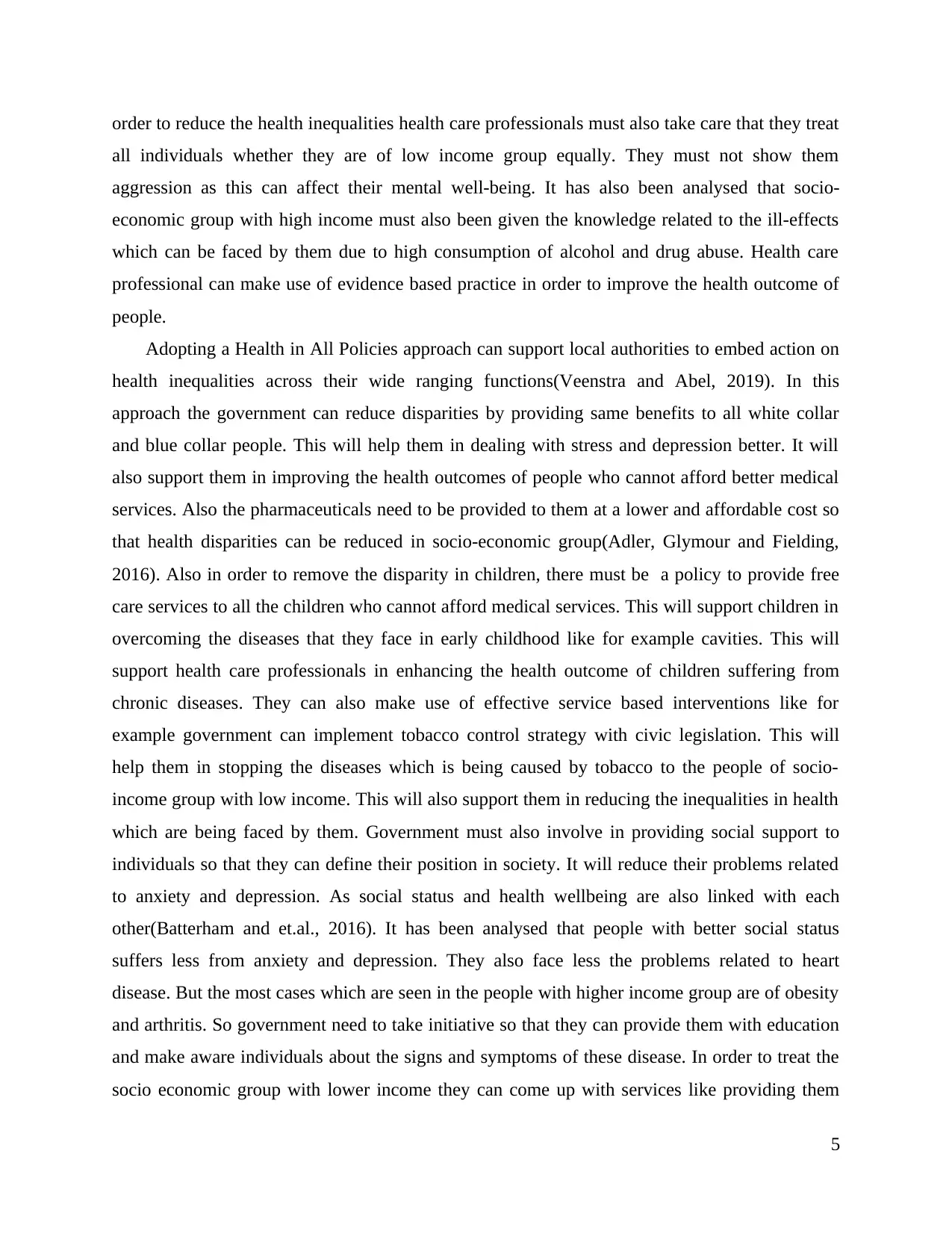
order to reduce the health inequalities health care professionals must also take care that they treat
all individuals whether they are of low income group equally. They must not show them
aggression as this can affect their mental well-being. It has also been analysed that socio-
economic group with high income must also been given the knowledge related to the ill-effects
which can be faced by them due to high consumption of alcohol and drug abuse. Health care
professional can make use of evidence based practice in order to improve the health outcome of
people.
Adopting a Health in All Policies approach can support local authorities to embed action on
health inequalities across their wide ranging functions(Veenstra and Abel, 2019). In this
approach the government can reduce disparities by providing same benefits to all white collar
and blue collar people. This will help them in dealing with stress and depression better. It will
also support them in improving the health outcomes of people who cannot afford better medical
services. Also the pharmaceuticals need to be provided to them at a lower and affordable cost so
that health disparities can be reduced in socio-economic group(Adler, Glymour and Fielding,
2016). Also in order to remove the disparity in children, there must be a policy to provide free
care services to all the children who cannot afford medical services. This will support children in
overcoming the diseases that they face in early childhood like for example cavities. This will
support health care professionals in enhancing the health outcome of children suffering from
chronic diseases. They can also make use of effective service based interventions like for
example government can implement tobacco control strategy with civic legislation. This will
help them in stopping the diseases which is being caused by tobacco to the people of socio-
income group with low income. This will also support them in reducing the inequalities in health
which are being faced by them. Government must also involve in providing social support to
individuals so that they can define their position in society. It will reduce their problems related
to anxiety and depression. As social status and health wellbeing are also linked with each
other(Batterham and et.al., 2016). It has been analysed that people with better social status
suffers less from anxiety and depression. They also face less the problems related to heart
disease. But the most cases which are seen in the people with higher income group are of obesity
and arthritis. So government need to take initiative so that they can provide them with education
and make aware individuals about the signs and symptoms of these disease. In order to treat the
socio economic group with lower income they can come up with services like providing them
5
all individuals whether they are of low income group equally. They must not show them
aggression as this can affect their mental well-being. It has also been analysed that socio-
economic group with high income must also been given the knowledge related to the ill-effects
which can be faced by them due to high consumption of alcohol and drug abuse. Health care
professional can make use of evidence based practice in order to improve the health outcome of
people.
Adopting a Health in All Policies approach can support local authorities to embed action on
health inequalities across their wide ranging functions(Veenstra and Abel, 2019). In this
approach the government can reduce disparities by providing same benefits to all white collar
and blue collar people. This will help them in dealing with stress and depression better. It will
also support them in improving the health outcomes of people who cannot afford better medical
services. Also the pharmaceuticals need to be provided to them at a lower and affordable cost so
that health disparities can be reduced in socio-economic group(Adler, Glymour and Fielding,
2016). Also in order to remove the disparity in children, there must be a policy to provide free
care services to all the children who cannot afford medical services. This will support children in
overcoming the diseases that they face in early childhood like for example cavities. This will
support health care professionals in enhancing the health outcome of children suffering from
chronic diseases. They can also make use of effective service based interventions like for
example government can implement tobacco control strategy with civic legislation. This will
help them in stopping the diseases which is being caused by tobacco to the people of socio-
income group with low income. This will also support them in reducing the inequalities in health
which are being faced by them. Government must also involve in providing social support to
individuals so that they can define their position in society. It will reduce their problems related
to anxiety and depression. As social status and health wellbeing are also linked with each
other(Batterham and et.al., 2016). It has been analysed that people with better social status
suffers less from anxiety and depression. They also face less the problems related to heart
disease. But the most cases which are seen in the people with higher income group are of obesity
and arthritis. So government need to take initiative so that they can provide them with education
and make aware individuals about the signs and symptoms of these disease. In order to treat the
socio economic group with lower income they can come up with services like providing them
5
Paraphrase This Document
Need a fresh take? Get an instant paraphrase of this document with our AI Paraphraser
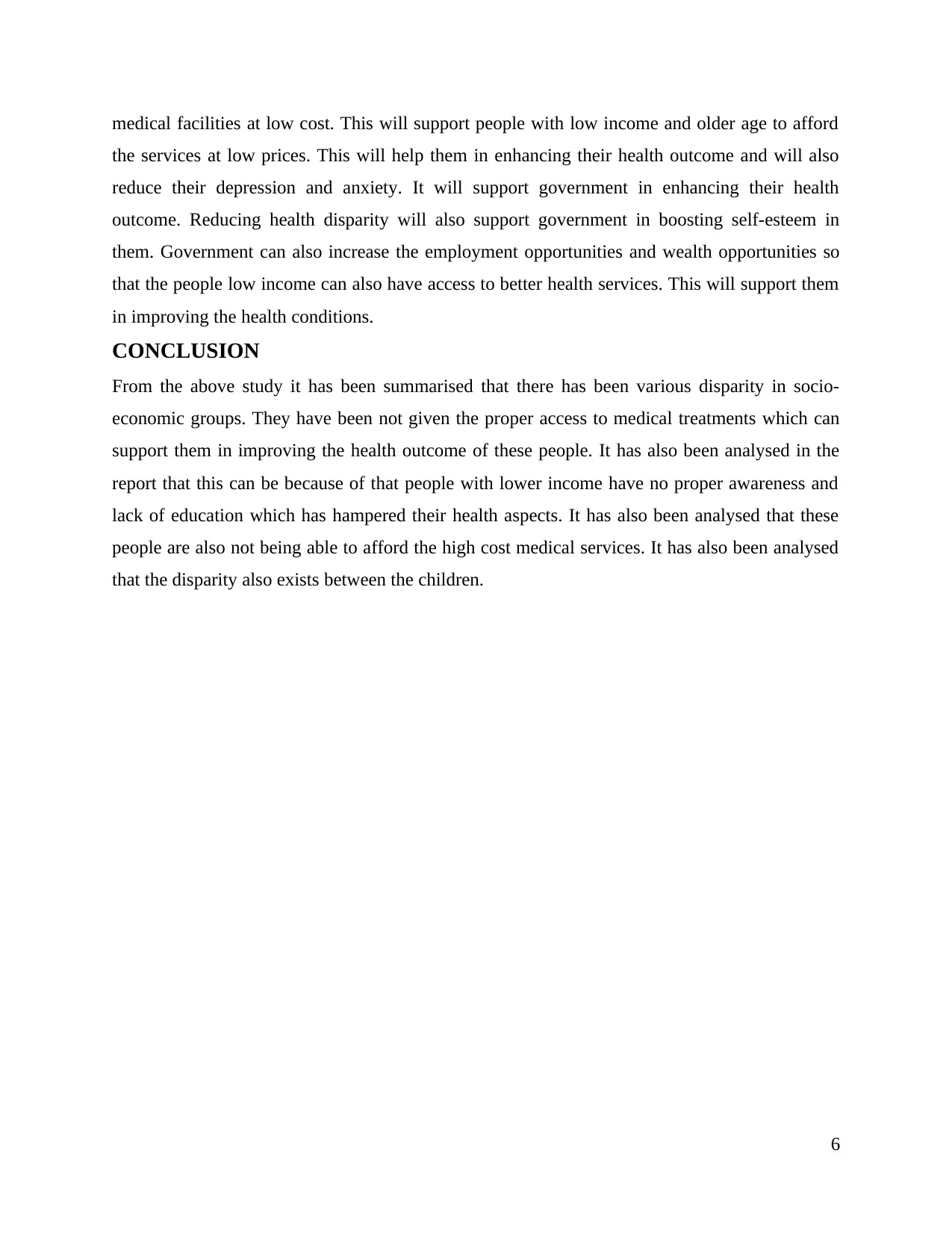
medical facilities at low cost. This will support people with low income and older age to afford
the services at low prices. This will help them in enhancing their health outcome and will also
reduce their depression and anxiety. It will support government in enhancing their health
outcome. Reducing health disparity will also support government in boosting self-esteem in
them. Government can also increase the employment opportunities and wealth opportunities so
that the people low income can also have access to better health services. This will support them
in improving the health conditions.
CONCLUSION
From the above study it has been summarised that there has been various disparity in socio-
economic groups. They have been not given the proper access to medical treatments which can
support them in improving the health outcome of these people. It has also been analysed in the
report that this can be because of that people with lower income have no proper awareness and
lack of education which has hampered their health aspects. It has also been analysed that these
people are also not being able to afford the high cost medical services. It has also been analysed
that the disparity also exists between the children.
6
the services at low prices. This will help them in enhancing their health outcome and will also
reduce their depression and anxiety. It will support government in enhancing their health
outcome. Reducing health disparity will also support government in boosting self-esteem in
them. Government can also increase the employment opportunities and wealth opportunities so
that the people low income can also have access to better health services. This will support them
in improving the health conditions.
CONCLUSION
From the above study it has been summarised that there has been various disparity in socio-
economic groups. They have been not given the proper access to medical treatments which can
support them in improving the health outcome of these people. It has also been analysed in the
report that this can be because of that people with lower income have no proper awareness and
lack of education which has hampered their health aspects. It has also been analysed that these
people are also not being able to afford the high cost medical services. It has also been analysed
that the disparity also exists between the children.
6
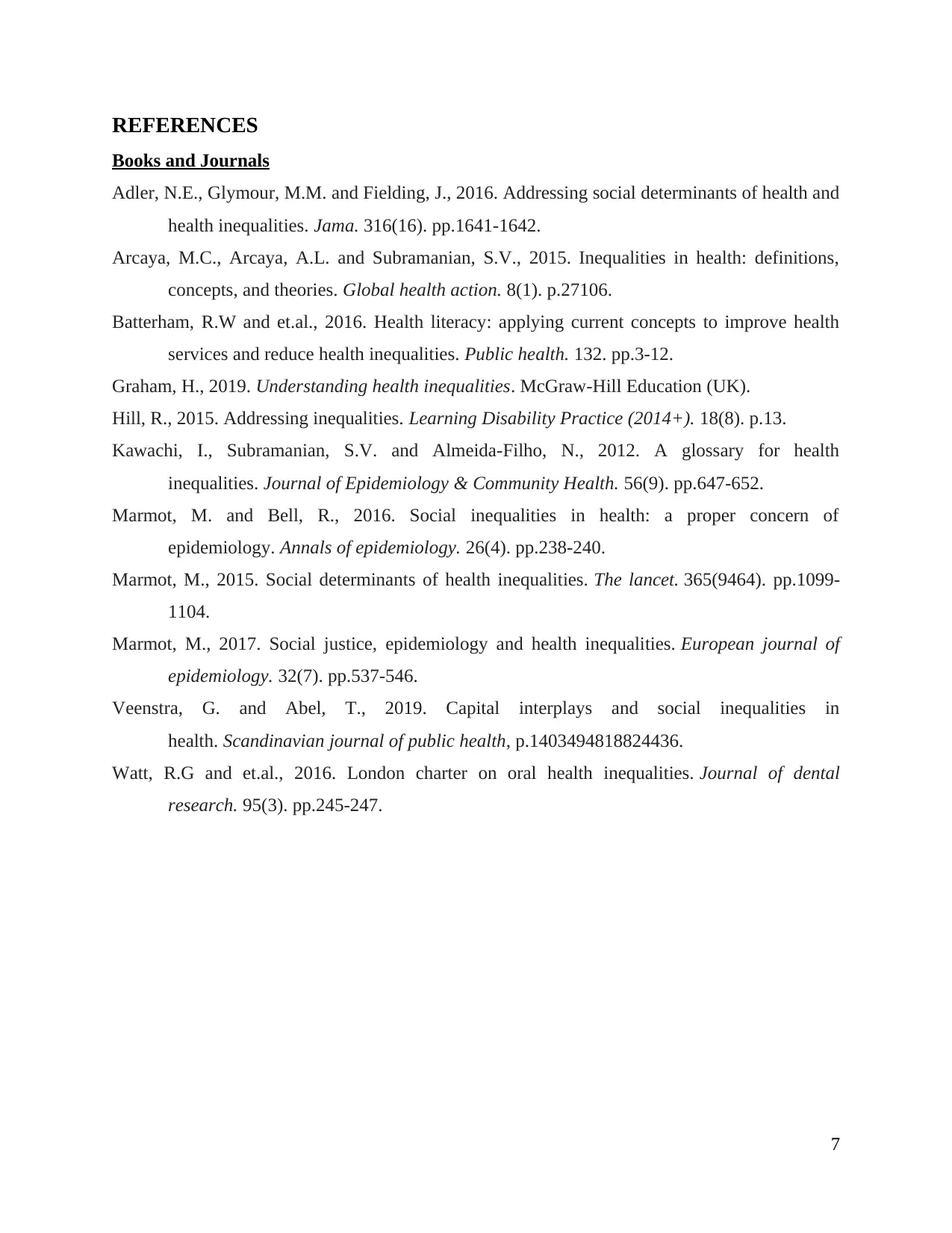
REFERENCES
Books and Journals
Adler, N.E., Glymour, M.M. and Fielding, J., 2016. Addressing social determinants of health and
health inequalities. Jama. 316(16). pp.1641-1642.
Arcaya, M.C., Arcaya, A.L. and Subramanian, S.V., 2015. Inequalities in health: definitions,
concepts, and theories. Global health action. 8(1). p.27106.
Batterham, R.W and et.al., 2016. Health literacy: applying current concepts to improve health
services and reduce health inequalities. Public health. 132. pp.3-12.
Graham, H., 2019. Understanding health inequalities. McGraw-Hill Education (UK).
Hill, R., 2015. Addressing inequalities. Learning Disability Practice (2014+). 18(8). p.13.
Kawachi, I., Subramanian, S.V. and Almeida-Filho, N., 2012. A glossary for health
inequalities. Journal of Epidemiology & Community Health. 56(9). pp.647-652.
Marmot, M. and Bell, R., 2016. Social inequalities in health: a proper concern of
epidemiology. Annals of epidemiology. 26(4). pp.238-240.
Marmot, M., 2015. Social determinants of health inequalities. The lancet. 365(9464). pp.1099-
1104.
Marmot, M., 2017. Social justice, epidemiology and health inequalities. European journal of
epidemiology. 32(7). pp.537-546.
Veenstra, G. and Abel, T., 2019. Capital interplays and social inequalities in
health. Scandinavian journal of public health, p.1403494818824436.
Watt, R.G and et.al., 2016. London charter on oral health inequalities. Journal of dental
research. 95(3). pp.245-247.
7
Books and Journals
Adler, N.E., Glymour, M.M. and Fielding, J., 2016. Addressing social determinants of health and
health inequalities. Jama. 316(16). pp.1641-1642.
Arcaya, M.C., Arcaya, A.L. and Subramanian, S.V., 2015. Inequalities in health: definitions,
concepts, and theories. Global health action. 8(1). p.27106.
Batterham, R.W and et.al., 2016. Health literacy: applying current concepts to improve health
services and reduce health inequalities. Public health. 132. pp.3-12.
Graham, H., 2019. Understanding health inequalities. McGraw-Hill Education (UK).
Hill, R., 2015. Addressing inequalities. Learning Disability Practice (2014+). 18(8). p.13.
Kawachi, I., Subramanian, S.V. and Almeida-Filho, N., 2012. A glossary for health
inequalities. Journal of Epidemiology & Community Health. 56(9). pp.647-652.
Marmot, M. and Bell, R., 2016. Social inequalities in health: a proper concern of
epidemiology. Annals of epidemiology. 26(4). pp.238-240.
Marmot, M., 2015. Social determinants of health inequalities. The lancet. 365(9464). pp.1099-
1104.
Marmot, M., 2017. Social justice, epidemiology and health inequalities. European journal of
epidemiology. 32(7). pp.537-546.
Veenstra, G. and Abel, T., 2019. Capital interplays and social inequalities in
health. Scandinavian journal of public health, p.1403494818824436.
Watt, R.G and et.al., 2016. London charter on oral health inequalities. Journal of dental
research. 95(3). pp.245-247.
7
⊘ This is a preview!⊘
Do you want full access?
Subscribe today to unlock all pages.

Trusted by 1+ million students worldwide
1 out of 9
Related Documents
Your All-in-One AI-Powered Toolkit for Academic Success.
+13062052269
info@desklib.com
Available 24*7 on WhatsApp / Email
![[object Object]](/_next/static/media/star-bottom.7253800d.svg)
Unlock your academic potential
Copyright © 2020–2025 A2Z Services. All Rights Reserved. Developed and managed by ZUCOL.





